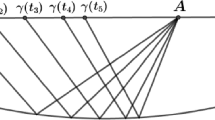Abstract
In an earlier paper we developed a unified approach to the extendability problem for arcs in PG(k - 1, q) and, equivalently, for linear codes over finite fields. We defined a special class of arcs called (t mod q)-arcs and proved that the extendabilty of a given arc depends on the structure of a special dual arc, which turns out to be a (t mod q)-arc. In this paper, we investigate the general structure of (t mod q)-arcs. We prove that every such arc is a sum of complements of hyperplanes. Furthermore, we characterize such arcs for small values of t, which in the case t = 2 gives us an alternative proof of the theorem by Maruta on the extendability of codes. This result is geometrically equivalent to the statement that every 2-quasidivisible arc in PG(k - 1, q), q ≥ 5, q odd, is extendable. Finally, we present an application of our approach to the extendability problem for caps in PG(3, q).
Similar content being viewed by others
References
Hirschfeld, J.W.P., Projective Geometries over Finite Fields, Oxford: Clarendon; New York: Oxford Univ. Press, 1998, 2nd ed.
Landjev I. and Storme L., Linear Codes and Galois Geometries, Current Research Topics in Galois Geometries, Storme L. and De Beule J., Eds., New York: Nova Sci. Publ., 2012, pp. 187–214.
MacWilliams F.J. and Sloane, N.J.A., The Theory of Error-Correcting Codes, Amsterdam: North-Holland, 1977. Translated under the title Teoriya kodov, ispravlyayushchikh oshibki, Moscow: Svyaz', 1979.
Heise W. and Quattrocchi P., Informations- und Codierungstheorie: mathematische Grundlagen der Daten-Kompression und -Sicherung in diskreten Kommunikationssystemen, Berlin: Springer, 1995, 3rd ed.
Tsfasman M.A., Vladut S.G., and Nogin, D.Yu., Algebraic Geometrie Codes: Basic Notions, Providence, R.I.: Amer. Math. Soc, 2007.
Griesmer J.H., A Bound for Error-Correcting Codes, IBM J. Res. Develop., 1960, vol. 4, no. 5, pp. 532–542.
Ward H.N., Divisible Codes-A Survey, Serdica Math. J., 2001, vol. 27, no. 4, pp. 263–278.
Hill R. and Lizak P., Extensions of Linear Codes, in Proc. Int. Symp. on Information Theory (ISIT'1995), Whistler, BC, Canada, Sept. 17–22, 1995, p. 345.
Hill R., An Extension Theorem for Linear Codes, Des. Codes Cryptogr., 1999, vol. 17, no. 1–3, pp 151–157.
Maruta T., On the Extendability of Linear Codes, Finite Fields Appl, 2001, vol. 7, no. 2, pp. 350–354.
Maruta T., Extendability of Linear Codes over GF(q) with Minimum Distance d, gcd(d, q) = 1, Discrete Math., 2003, vol. 266, no. 1–3, pp. 377–385.
Maruta T., A New Extension Theorem for Linear Codes, Finite Fields Appl, 2004, vol. 10, no. 4, pp. 674–685.
Maruta T., Extension Theorems for Linear Codes over Finite Fields, J. Geom., 2011, vol. 101, no. 1–2, pp. 173–183.
Yoshida Y. and Maruta T., An Extension Theorem for [n, k, d]q Codes with gcd(d, q) = 2, Australas. J. Combin., 2010, vol. 48, pp. 117–131.
Landjev I., Rousseva A., and Storme L., On the Extendability of Quasidivisible Griesmer Arcs, Des. Codes Cryptogr., 2016, vol. 79, no. 3, pp. 535–547.
Dodunekov S. and Simonis J., Codes and Projective Multisets, Electron. J. Combin., 1998, vol. 5, no. 1, Research Paper R37.
Landjev I., The Geometric Approach to Linear Codes, Finite Geometries (Proc. 4th Isle of Thorns Conf, Chelwood Gate, UK, July 16–21, 2000), Blokhuis A., Hirschfeld, J.W.P., Jungnickel D., and Thas J.A., Eds., Dordrecht: Kluwer, 2001, pp. 247–257.
Hamada N., The Rank of the Incidence Matrix of Points and d-Flats in Finite Geometries, J. Sci. Hiroshima Univ. Ser. A-I Math., 1968, vol. 32, no. 2, pp. 381–396.
Ceccherini P.V. and Hirschfeld, J.W.P., The Dimension of Projective Geometry Codes, Discrete Math., 1992, vol. 106/107, pp. 117–126.
Goethals, J.-M. and Delsarte P., On a Class of Majority-Logic Decodable Cyclic Codes, IEEE Trans. Inform. Theory, 1968, vol. 14, no. 2, pp. 182–188.
MacWilliams F.J. and Mann H.B., On the p-Rank of the Design Matrix of a Difference Set, Inform. Control, 1968, vol. 12, no. 5, pp. 474–488.
Smith, K.J.C., On the p-Rank of the Incidence Matrix of Points and Hyperplanes in a Finfite Projective Geometry, J. Combin. Theory, 1969, vol. 7, no. 2, pp. 122–129.
Blokhuis A. and Moorhouse G.E., Some p-Ranks Related to Orthogonal Spaces, J. Algebraic Combin., 1995, vol. 4, no. 4, pp. 295–316.
Ball S., Hill R., Landjev I., and Ward H., On (q 2 + q + 2, q + 2)-Arcs in the Projective Plane PG(2, q), Des. Codes Cryptogr., 2001, vol. 24, no. 2, pp. 205–224.
Hirschfeld, J.W.P., Finite Projective Spaces in Three Dimensions, Oxford: Oxford Univ. Press, 1985.
Bruen A., Baer Subplanes and Blocking Sets, Bull. Amer. Math. Soc, 1970, vol. 76, no. 2, pp. 342–344.
Polverino, O. Small Blocking Sets in PG(2, p 3), Des. Codes Cryptogr., 2000, vol. 20, no. 3, pp. 319–324.
Sziklai P. and Szőnyi T., Blocking Sets and Algebraic Curves, Rend. Circ. Mat. Palermo (2) Suppl., 1998, no. 51, pp. 71–86.
Landjev I. and Vandendriessche P., A Study of (xv t , x-y t-t)-Minihypers in PG(t, q), J. Combin. Theory Ser. A, 2012, pp. 119, no. 6, pp. 1123–1131.
Funding
This research has been supported by the Science Research Fund of Sofia University under Contract no. 80-10-81/15.04.2019.
Author information
Authors and Affiliations
Corresponding author
Additional information
Russian Text © The Author(s), 2019, published in Problemy Peredachi Informatsii, 2019, Vol. 55, No. 3, pp. 30–45.
Rights and permissions
About this article
Cite this article
Landjev, I., Rousseva, A. Divisible Arcs, Divisible Codes, and the Extension Problem for Arcs and Codes. Probl Inf Transm 55, 226–240 (2019). https://doi.org/10.1134/S0032946019030037
Received:
Revised:
Accepted:
Published:
Issue Date:
DOI: https://doi.org/10.1134/S0032946019030037



